Recipes
Get to Know the Characters through Their Recipes
Lieutenant Gus Olivera’s Gazpacho
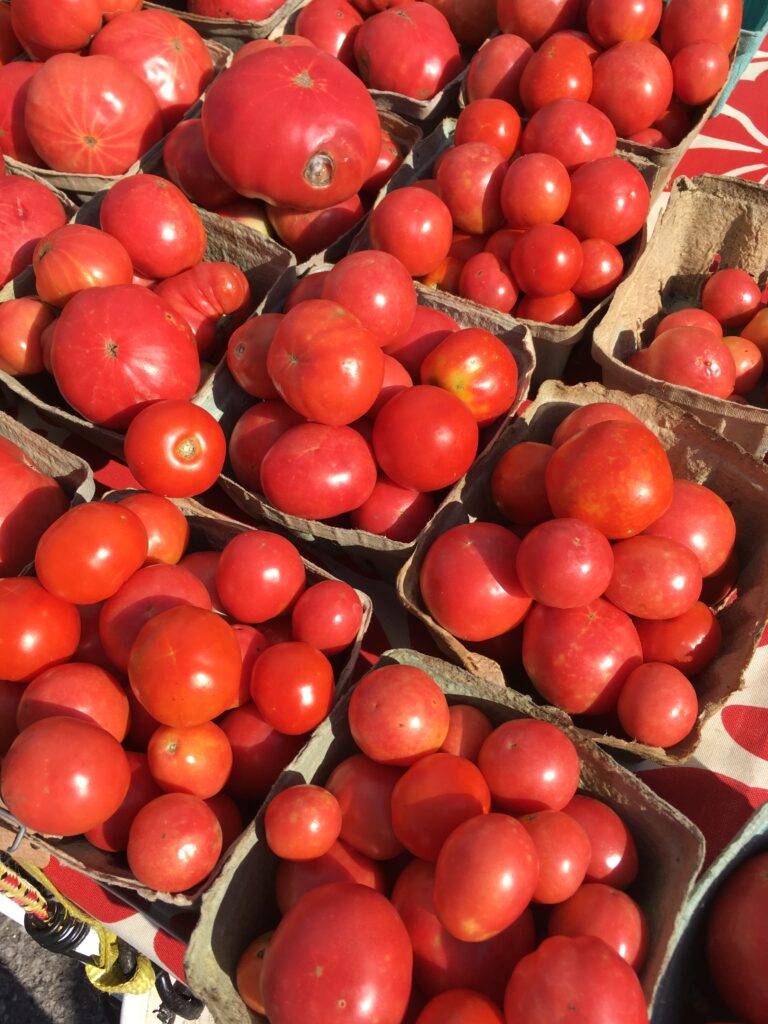
Gus Olivera, a tall, dark, handsome California import, was a VIP in his old job in Santa Clara, California, but, having moved to Hembree a little over a year ago, he has settled into small-town Delta society rather well. As Chief of Police, he appears first in Murder at Waite House, where he plays antagonist to amateur sleuth Mosey Frye’s role as protagonist. Yet as the series progresses, his prominence in the narrative builds until in The Incident at Sunny Banks the two characters are running neck and neck for the lead. It even becomes less predictable who will solve the mystery first, Gus or Mosey. By the way, there’s a big surprise coming in The Incident at Sunny Banks. I won’t spoil it for you. I’ll just say it is, indeed, big and has been a very long time coming.
Excerpt
Gus recognized the man lifting a box of tomatoes onto the truck bed. He picked a tomato out of a basket. “You know, Frank, we’re heading into October, and it’s still hot as blazes. You plant any pumpkins this year?”
Ferguson, in neatly ironed overalls and a trim straw hat, set his box down. “You thinkin’ about Halloween already, Lieutenant?” He removed his hat and extended a knobby hand.
“How’s it going, Frank?” Gus said as he shook Frank’s hand.
“Not bad, considering.” He wiped his brow with the sleeve of his gingham shirt.
“Before you haul those off, how about filling a sack with your ripest tomatoes. Think I’ll make a cool bowl of gazpacho.”
“Go ahead and grab the ones you want.” He handed him a paper bag. “But I wouldn’t have figured you for a cook.” He chuckled.
“No cooking to it. Just throw a few vegetables into a food processor and—”
Before he could finish enlightening Frank Sr. on the particulars of a California-style gazpacho, Frank Jr., who was sitting in the cab, rolled the window down and shouted, “Daddy!”
“Hold on, son. I was helping the lieutenant here.”
Frank Jr. opened the door and stepped out. “Sorry, Lieutenant, didn’t see you.”
“Looks like you’ve raised a fine crop of tomatoes, Frank. Can’t make a good gazpacho without ripe, tasty tomatoes.”
Frank Jr. sniggered. “That’s like tomato soup, right? Except people eat it cold.”
“Uh-huh, you ever try it?”
“No, can’t say I have.”
“Think I’ll take a couple of green peppers, too.”
“Pardon me for, uh, bringing it up,” Frank Sr. cut in, “but I was wondering. You got any idea who killed Sister Clare?”
Gus’s Gazpacho
- 4-5 large red ripe tomatoes
- ½ large cucumber
- 1 sweet Italian pepper
- ½ small yellow onion
- several small garlic cloves
- handful of day-old bread crumbs
- wine vinegar
- extra virgin olive oil
- salt to taste
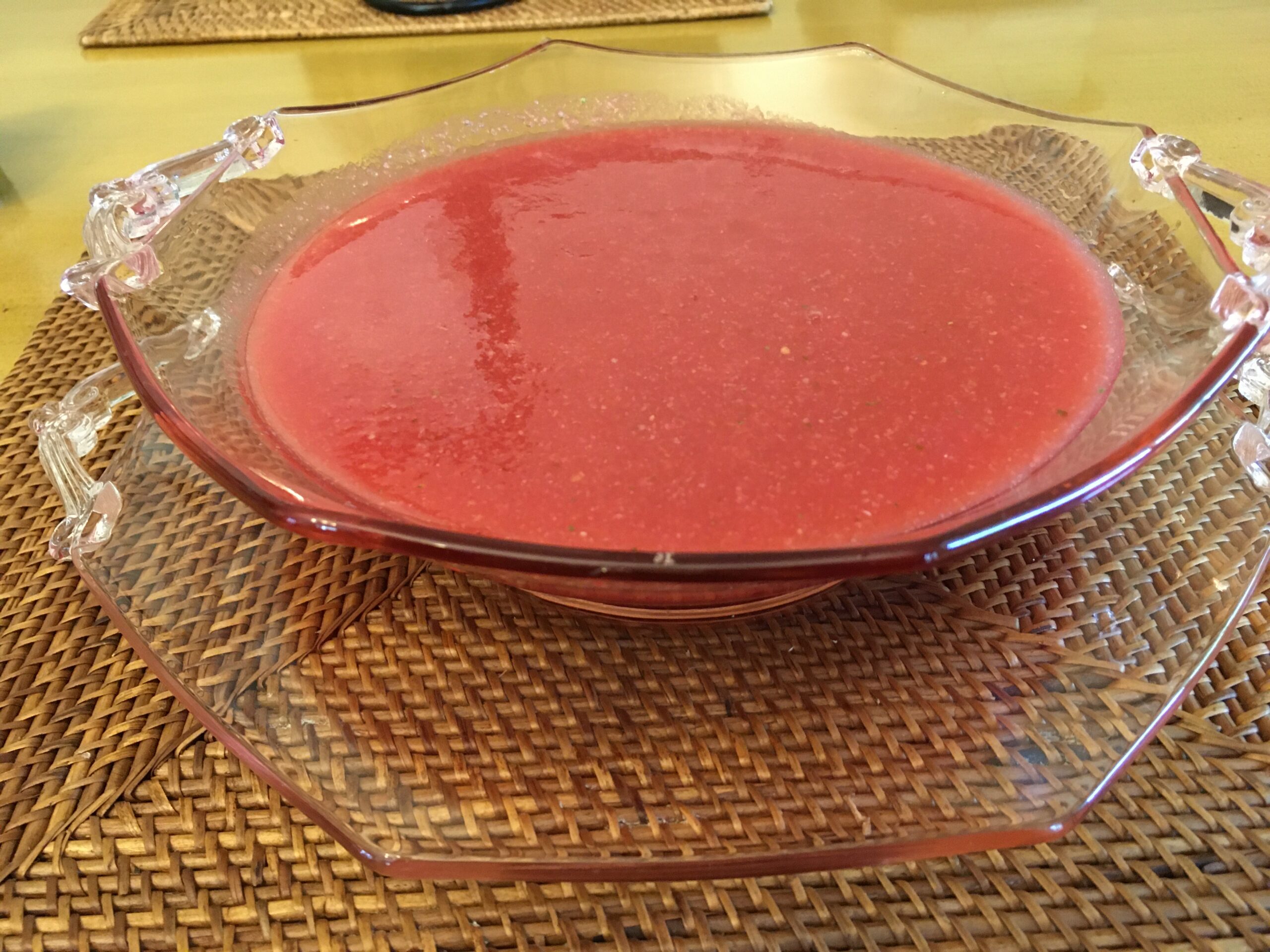
Wash the vegetables and cut into large pieces, and if you have a ricer, you won’t need to peel and core them. In small batches, place the vegetables in a food processor and pulse until reduced to a thick liquid. Add the bread with the last batch of vegetables. Pour the liquid into a ricer and turn the crank until most of the mixture has passed through.
Once you have transferred the gazpacho into a refrigerator container, add salt, vinegar, and oil. As you season the soup, it is important to taste it at intervals, given that the acidity of the tomatoes will determine how much of each you will add. I suggest adding salt by the ¼ teaspoonful, stirring and tasting after each addition. Also, use a tasty oil and vinegar. You may want to add a tablespoon or less of each, depending on your preference.
You may also balance out the flavor of your gazpacho by adding garnishes such as chopped cucumber, chopped pepper, croutons, and even jamón serrano, if you are lucky enough to find some.
Saffron Smiley’s Succotash
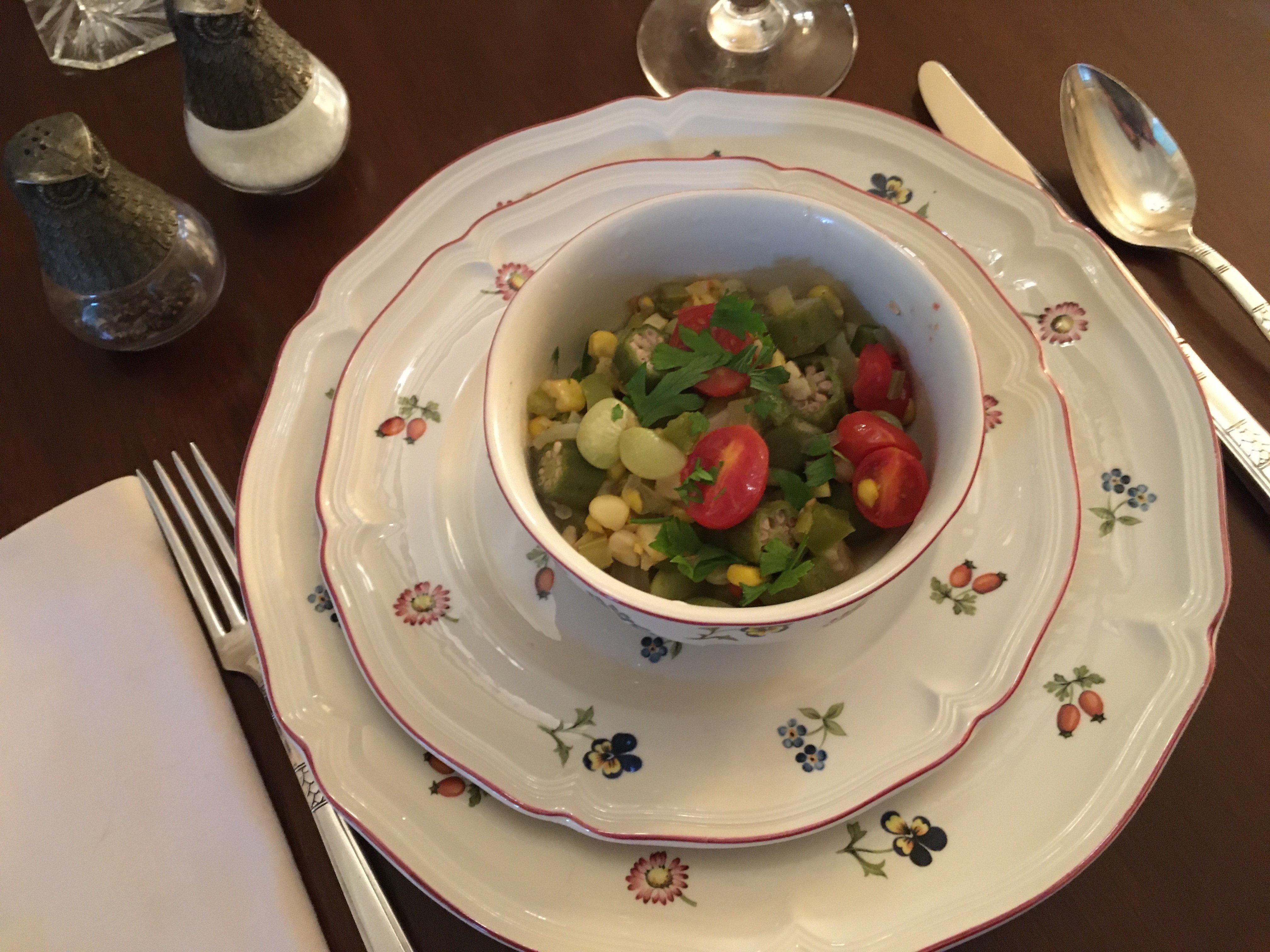
Saffron Smiley, who appears first in Murder at Waite House, is John Earle Shepherd’s personal assistant and Mosey’s co-worker at Shepherd Realty. She tempts Mosey and John Earle with her homemade concoctions, most of which fit into the “soul food” category, though Hembreeites, regardless of race, grew up eating biscuits, butter roll, fried pies and the like. Saffron, a consummate cook, often takes a traditional recipe in a slightly different direction, switching out butter or shortening for lighter, more healthful olive oil. She likes to serve succotash—a vegetable dish par excellence—European style (as a separate dish) along with cornbread. She follows it up with grilled salmon garnished with lemon. A light white wine, such as a Pinot Grigio, goes well with each dish. You may want to make this delicious dish right away, and you can, using frozen vegetables, given that in many climes, good fresh vegetables are not readily available. But if you want to make your guests swoon, serve them this dish made with vegetables from your summer garden.
Excerpt
Saffron visits Uncle T. Patrick, known as Big-Eye, at the Magnolia Nursing home and takes him a sack of fried pies.
“Fried pies. Oo-we, I can smell ‘em.”
“What kind of fried pies?” She smiled broadly.
“Persimmon.”
“Persimmon? Where you think I’d get any persimmons?”
“Peach.”
“That’s right. You want one?” She opened a tin foil package and pulled out a crispy pie, placed it on a cloth napkin, and offered it to Big-Eye.
“Lordy, you’re good to your old uncle. Yes, you are.” He took a bite of the pie. “Uh, uh, uh. You cook better than your momma.”
“Don’t let her hear you say that.” She leaned over and gave her uncle a peck on the cheek.
Saffron’s Succotash
- 1-2 tablespoons olive oil
- 1 cup chopped onion
- 1 cup chopped green bell pepper
- 1 cup chopped celery
- 2 cloves minced garlic
- 1 minced jalapeño, without seeds
- 1 cup cooked corn, off the cob
- 1 cup cooked lima beans
- 1 cup or more sliced okra
- 1-2 tablespoons butter
- water as needed
- salt and pepper
- parsley as a garnish
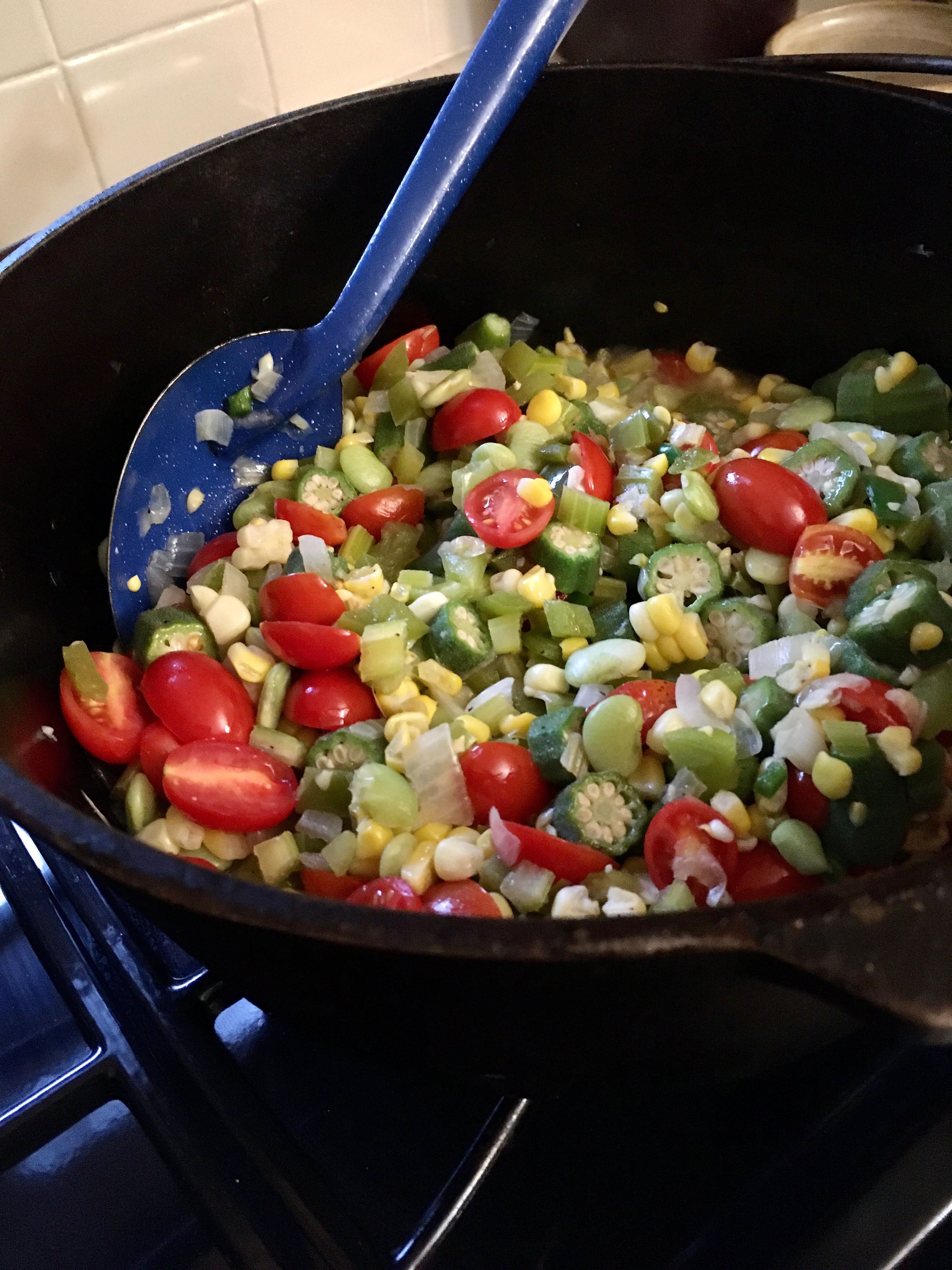
Heat olive oil in a heavy pan over medium heat. Add onion, bell pepper, and celery, stirring occasionally until the vegetables are tender. Add garlic and cook one minute. Add jalapeño, corn, lima beans, and okra. Add butter. Stir and add water as needed. Salt can be added all along or at the end. Add pepper to taste. Cover and cook on low heat for about 20 minutes. Taste. Cook longer if necessary to attain the desired tenderness. Serve in a bowl or individual bowls, topped with chopped Italian parsley.
Lucille’s Shrimp Gumbo Lite
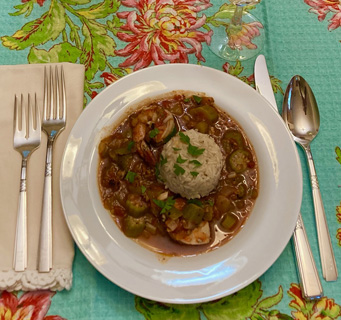
Book #4 introduces Antoine (or A. B.) Bilyeu, longtime resident of New Orleans, and his nephew Cecil DeGroat, attorney and right-hand man to his Uncle Antoine. Antoine’s wife Lucille, of whom we see very little in the early novels of the series, leaves us, nonetheless, with our mouths watering, just dying for a taste of her Creole cooking, or a sip of an icy mojito stuffed with home-grown mint, or a crunchy cheese straw, spiced up with a dash or two of hot sauce. Lucille has kindly agreed to share her recipe for Shrimp Gumbo Lite, which she concocted with A. B. in mind. She says she’s bought him the last alligator-skin belt she ever plans to buy, and, regardless, will not replace it with a larger size. We thank her in advance for what we hope will become a reader favorite.
Excerpt
The kitchen door sprang open, and a heady aroma of Creole food wafted in from the kitchen. Lucille Bilyeu, red-faced and heavy-set, emerged in a cloud of steam. She winked at her nephew by marriage and said, “You men ready for a little dish of crawfish étouffée? I’ve got bread puddin’ for dessert.” She disappeared as quickly as she’d come.
“I guess we’re eating in the dining room,” Bilyeu said, rising to go.
DeGroat remained in his seat.
“You coming?”
“What does she know about any of this?” DeGroat said.
Bilyeu raised his index finger to his puckered lips. “Not a word.”
Shrimp Gumbo Lite
- 1-2 tablespoons olive oil
- 1 andouille sausage, whole, sliced, or chopped
- 1 cup yellow onion, chopped
- 2/3 cup bell pepper, chopped
- 2/3 cup celery, chopped
- 2 cloves garlic, finely chopped
- 2-3 cups fresh okra
- 1 tablespoon Italian seasoning
- 1 teaspoon cumin
- 1 teaspoon Creole seasoning
- 1/2 teaspoon paprika
- Tabasco to taste
- 1 15-ounce can crushed fire-roasted tomatoes
- 1 bay leaf
- stock (vegetable or chicken) to augment sauce
- 1 dozen medium shrimp, headed and deveined
- Cooked rice, filé, and a little fresh, chopped parsley for serving
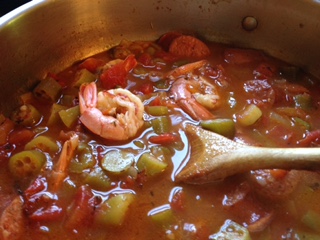
Warm the olive oil in a large pot over medium heat. Add the sausage, onion, green pepper, and celery and sauté, stirring regularly until the sausage is cooked and the vegetables are soft. Add the garlic, Italian seasoning, cumin, Creole seasoning, and paprika. Stir occasionally, cooking for about 10 minutes. Add the tomatoes with the juice. Add okra. Stir and bring to a simmer. Add bay leaf and stock to achieve desired thinness. Cook on simmer, partially covered, for 10-15 minutes. During the last 3 minutes of cooking, add the shrimp, being careful not to overcook. When the shrimp are pink, they are done, but test one to be sure. Serve in a bowl with a scoop of rice. Sprinkle with filé and a little fresh, chopped parsley.
Easy Grillades and Grits
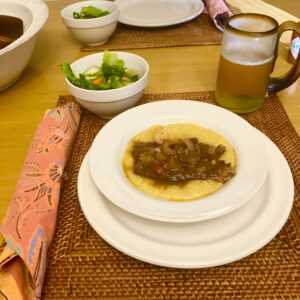
“Grillades,” pronounced GREE-yahds, is a Creole dish of Spanish origin. These tasty steaks are often served over grits (Mosey prefers stone-ground yellow grits), but they also pair well with rice or mashed potatoes. Mosey favors “easy” when anything kitchen-related is concerned, so after she has seared the steaks, she pushes aside the traditionally-used Dutch oven and puts the steaks and sauce in a crockpot to cook, which guarantees a piece of meat that is done and perfectly tender. In a pinch, she might serve the grillades over processed grits, but her better angels tend to nudge her to stick with the stone-ground variety.
Excerpt
The Hembree Marina is one of a few places between Memphis and New Orleans to offer fuel
and deep water dockage to river travelers, and on Wednesday nights, locals and out-of-towners
hazard the swaying footbridge to the Yacht Club to feast on shrimp, crab, and oysters, shipped in
daily from the Gulf Coast. Around eight, Mosey and Nadia line up at the buffet, while Robert
and Hugh wait for a table. Tonight they’re going for a Delta favorite—fried anything.
“So Lauren left, I’m assuming.” Nadia picked up plates for herself and Mosey.
“Yeah,” Mosey said, “she wanted to get back to Philadelphia before the bad weather
hit, but between me and you, I’m not sure that was all it was to it.” She reached for a crab leg.
“You want one of these?”
Nadia shook her head. “If not the weather, what then?”
“The body, of course.”
“Wouldn’t run me off,” Nadia said, “not if I liked the place.”
Standing before a platter of fried butterfly shrimp, Mosey spooned a helping onto her
plate and another onto Nadia’s. “I’ve always wondered why the Eldridge place was called Sunny
Banks—haven’t you?”
“The gum brake and the slough—must be.”
“Maybe,” Mosey said. “Not sure how long it’s been called that. Could be when the
house was first built, the family had a dock or maybe a houseboat on the river.” She picked up a
stuffed crab. “You want one of these?”
“I’ll pass.” Nadia looked sideways at Mosey. “You think they’d allow a private dock
right on the river?”
“Yum, fried okra.” Mosey scooped up a serving. “Does seem a little treacherous.”
Nadia plucked a piece from Mosey’s plate.
“Hey!”
“Just checking to see if it’s good and crispy.” Nadia held out her plate, and Mosey
scooped up another serving.
“The current is pretty strong, even along the banks,” Mosey said. “Remember that fool
guy—what was his name?—who tried to swim across on graduation night?”
“A professional swimmer couldn’t swim that river, much less a drunk teenager.”
Grillades and Grits
- 2 pounds bottom round steak, cut in ½ inch steaks
- 3 tablespoons flour
- 1 tablespoon olive oil
- ½ teaspoon each of salt, pepper, and paprika
- ½ cup celery, chopped
- ½ cup onion, chopped
- ½ cup bell pepper, chopped
- 1 large clove garlic, finely diced
- 1 teaspoon Creole seasoning
- 1 teaspoon Italian seasoning
- ½ 15-ounce can diced tomatoes
- 1 cup broth
- 2 cups stone-ground grits
- 1 teaspoon salt
- 1 tablespoon butter
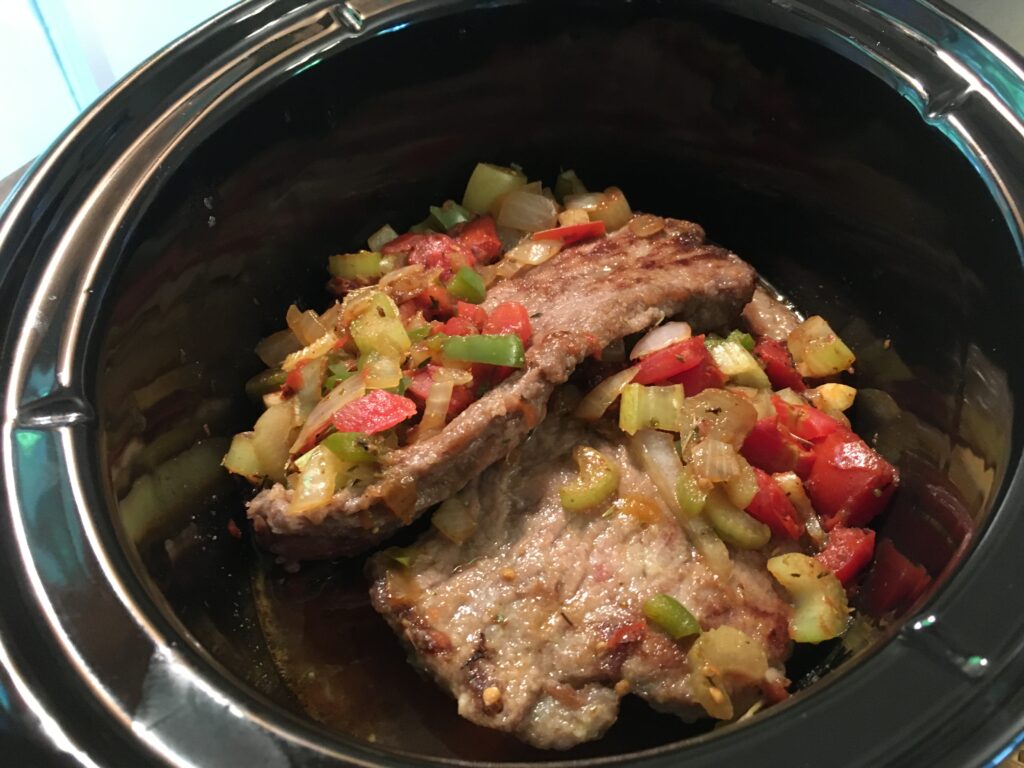
Mix the flour, salt, pepper, and paprika in a plastic bag and shake each steak separately to coat. Heat the olive oil in an iron skillet over medium-high heat. Sear the steaks on each side and remove them from the skillet. Add more oil to the skillet, if needed, and sauté the celery, onion, and bell pepper till tender. Add the garlic and sauté for one additional minute. Add Creole seasoning and Italian seasoning and stir, then the tomatoes and broth and stir again. Transfer the steaks to the crockpot, pouring in some of the sauce on top of each steak. Cover and cook on low for 4 hours. Test the meat for doneness and, if needed, cook a little more to achieve desired tenderness. To cook the grits, bring the water to a boil and stir in the salt and grits. Reduce to a simmer and cook uncovered, stirring or whisking frequently, for 40 to 50 minutes. When done, stir in the butter. Serve each steak over a mound of grits and cover with a couple of spoons of sauce. Accompany with a crisp salad.
Lucille’s Festive Jambalaya
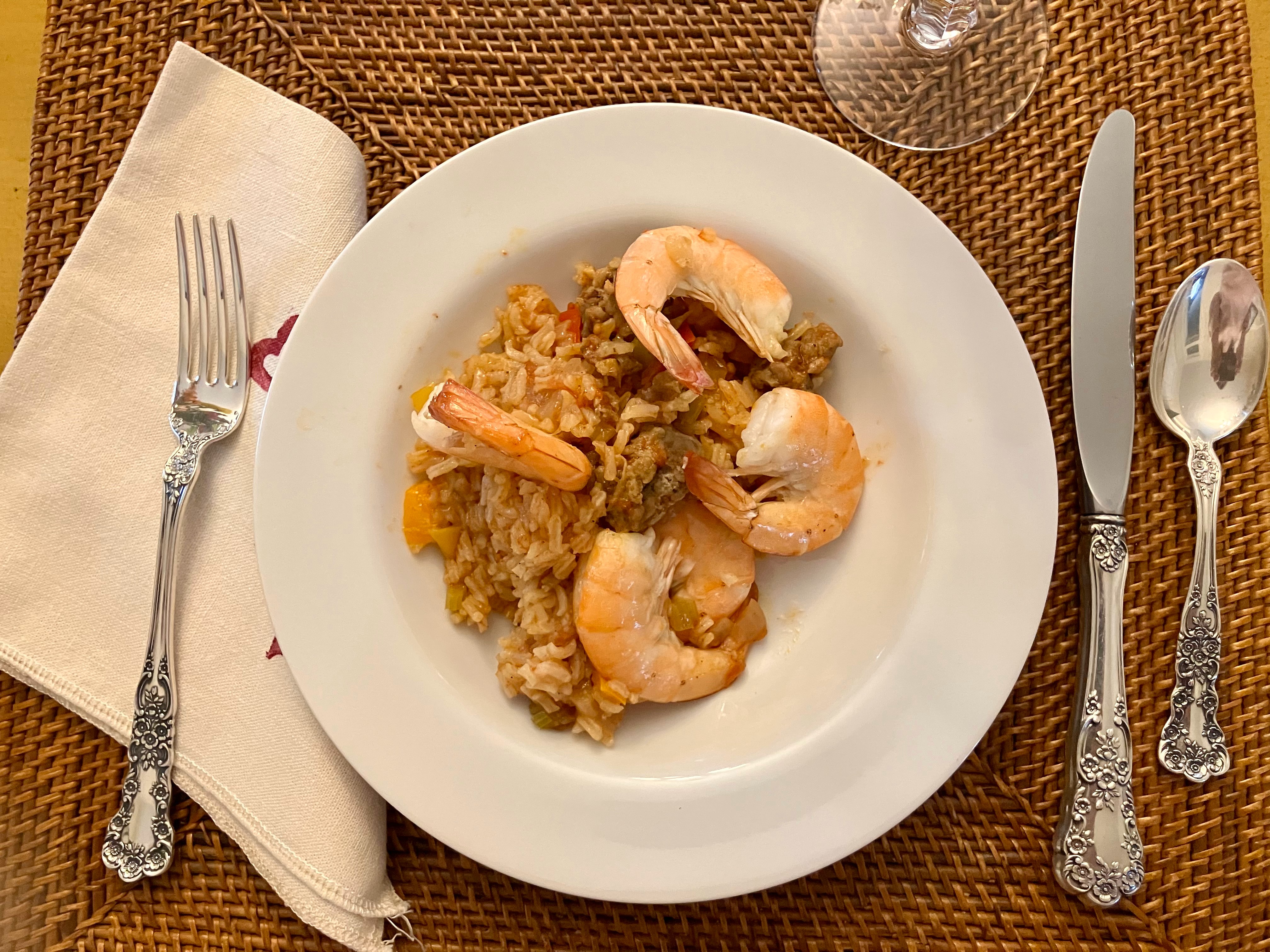
It’s been a while since we’ve heard from Lucille Bilyeu, but her husband A. B. and his nephew Cecil DeGroat are certainly making headlines in The House with a Secret Cellar. You might have thought you’d seen the last of them in The Summer House at Larkspur, but, no, indeed! Those two will be in Hembree for a spell, considering they’ve got the Summer House to restore. Lucille has graciously shared her Festive Jambalaya recipe just in time for Mardi Gras. She insists on using three shades of bell peppers—red, yellow, and orange—to make this dish truly festive. And during this season, she recommends using shrimp instead of chicken. But feel free to personalize with your choice of meat, poultry, or seafood. She’s even been known to add rabbit for an extra twist
Excerpt
In this passage from The House with a Secret Cellar, David Morrell, art dealer and specialist in casta paintings, engages in conversation with a mysterious stranger, who shares his fascination with the painting of A. B. Bilyeu’s infamous ancestor.
Philpot stepped in closer to have a better look at the image that had so thoroughly captured his attention. Little more than an adolescent, the young woman in the painting wore a white silk organza gown with a vibrant blue cabochon pinned at the bottom of a plunging neckline. A black lace mantilla rested elegantly on her head, secured by a gold peineta. Her hands, fair and delicate, sat one above the other, adding the finishing touch to the stunning portrait.
“Who is she?” he asked.
“Fernanda de Lobos, the wife of Hershel Bilyeu, one of the city’s first pharmacists. Actually, his apothecary is still standing, around the corner not far from here.”
“I was told,” he glanced at Morell, “that your collection was primarily of casta paintings, so I’m surprised to see this one here.”
“Yes, that’s correct. But this is, in fact, a casta painting, one of my earliest acquisitions.”
Lucille’s Festive Jambalaya
- 2 tablespoons olive or peanut oil
- andouille sausage, sliced
- shrimp
- 1 onion, diced
- 1 cup in all of yellow, red, and orange bell pepper, diced
- 2 ribs celery, diced
- 3 cloves garlic, minced
- 1 tablespoon Cajun seasoning
- ¼-½ teaspoon red pepper flakes
- ¼-½ teaspoon ground black pepper
- 1 teaspoon salt
- file powder to taste
- 1-2 cups crushed tomatoes
- hot pepper sauce to taste
- Worcestershire sauce to taste
- 1 cup uncooked white rice
- 2 ½ cups chicken broth
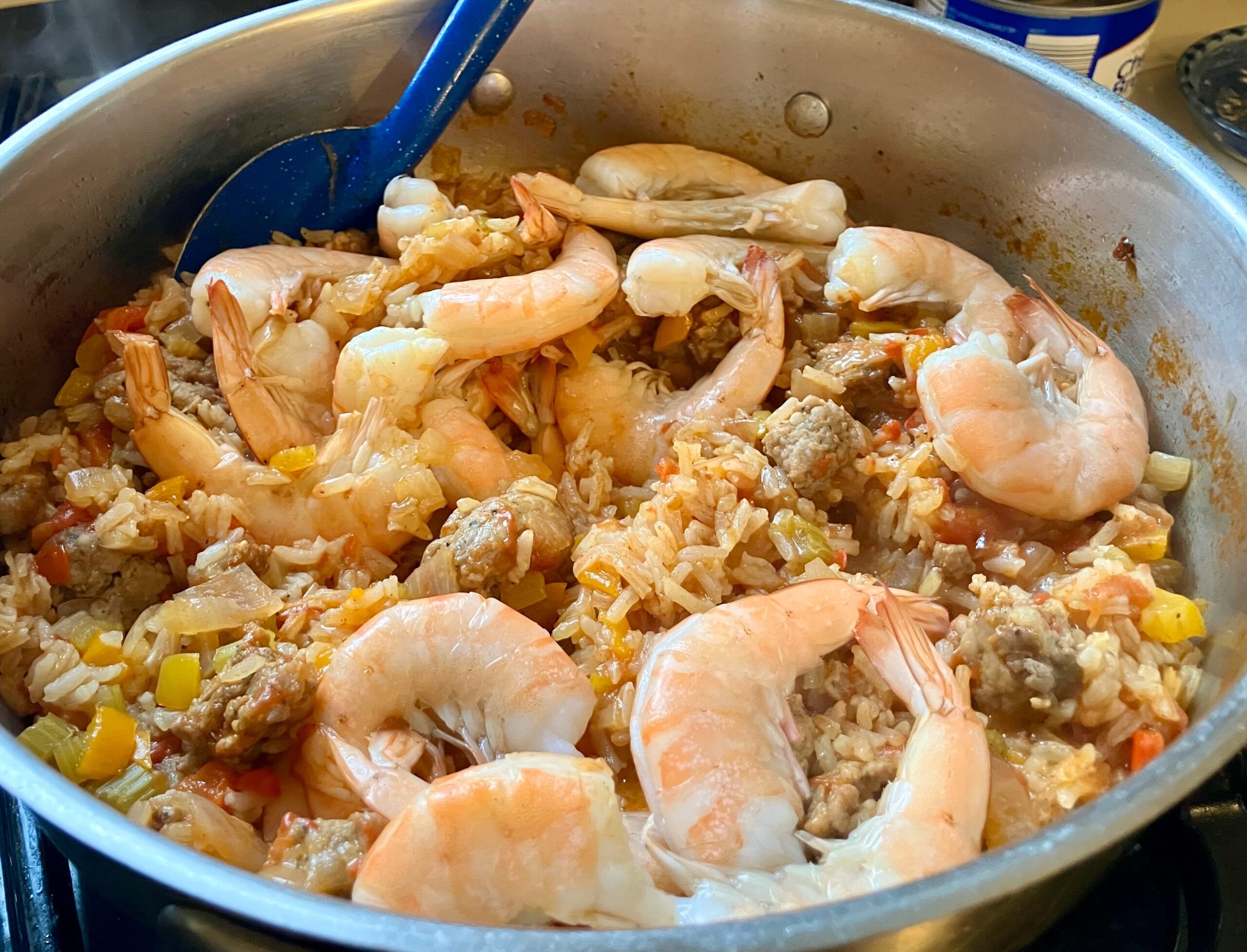
Heat the oil in a large skillet over low to medium heat and sauté the sausage, which you have cut into one-inch pieces. Remove the sausage and add the vegetables except for the garlic. Sauté them until tender, adding the garlic toward the end. Cook for about another minute. Next, add all the dry seasonings and stir for about a minute. Add the tomatoes, sausage, and sauces and cook over medium heat for 10-12 minutes. Add the rice and broth and stir once. Reduce the heat and simmer, covered, for 20 to 25 minutes or until the rice is done. If needed, add a little water or broth toward the end. Add the raw shrimp last and cook until done but not overdone. When the shrimp turns pinkish and curls a bit, it’s done. Lucille prefers to leave the shrimp in the shells, but you may shell them beforehand if you prefer.